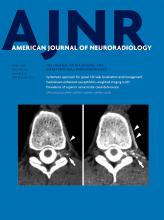Research ArticleAdult Brain
Open Access
Behavioral and Structural Effects of Single and Repeat Closed-Head Injury
Y.-C.J. Kao, Y.W. Lui, C.-F. Lu, H.-L. Chen, B.-Y. Hsieh and C.-Y. Chen
American Journal of Neuroradiology April 2019, 40 (4) 601-608; DOI: https://doi.org/10.3174/ajnr.A6014
Y.-C.J. Kao
aFrom the Neuroscience Research Center (Y.-C.J.K., C.-Y.C.)
bTranslational Imaging Research Center (Y.-C.J.K., C.-Y.C.), Taipei Medical University, Taipei, Taiwan
cDepartment of Radiology (Y.-C.J.K., C.-Y.C.), School of Medicine, College of Medicine, Taipei Medical University, Taipei, Taiwan
hRadiogenomic Research Center (Y.-C.J.K., C.-Y.C.), Taipei Medical University Hospital, Taipei, Taiwan
Y.W. Lui
dDepartment of Radiology (Y.W.L.), NYU School of Medicine/NYU Langone Health, New York, New York
C.-F. Lu
eDepartment of Biomedical Imaging and Radiological Sciences (C.-F.L.), National Yang-Ming University, Taipei, Taiwan
H.-L. Chen
fDepartments of Medical Research (H.-L.C.)
B.-Y. Hsieh
iDepartment of Biomedical Imaging and Radiological Science (B.-Y.H.), China Medical University, Taichung, Taiwan.
C.-Y. Chen
aFrom the Neuroscience Research Center (Y.-C.J.K., C.-Y.C.)
bTranslational Imaging Research Center (Y.-C.J.K., C.-Y.C.), Taipei Medical University, Taipei, Taiwan
cDepartment of Radiology (Y.-C.J.K., C.-Y.C.), School of Medicine, College of Medicine, Taipei Medical University, Taipei, Taiwan
gMedical Imaging (C.-Y.C.)
hRadiogenomic Research Center (Y.-C.J.K., C.-Y.C.), Taipei Medical University Hospital, Taipei, Taiwan

REFERENCES
- 1.↵
- Sosin DM,
- Sniezek JE,
- Thurman DJ
- 2.↵
- 3.↵
- 4.↵
- 5.↵
- 6.↵
- 7.↵
- 8.↵
- 9.↵
- Marmarou A,
- Foda MA,
- van den Brink W, et al
- 10.↵
- 11.↵
- 12.↵
- Kao YJ,
- Oyarzabal EA,
- Zhang H, et al
- 13.↵
- 14.↵
- 15.↵
- 16.↵
- Hamm RJ
- 17.↵
- 18.↵
- Green EW,
- O'Callaghan EK,
- Hansen CN, et al
- 19.↵
- 20.↵
- Namjoshi DR,
- Good C,
- Cheng WH, et al
- 21.↵
- 22.↵
- 23.↵
- 24.↵
- Shultz SR,
- Bao F,
- Omana V, et al
- 25.↵
- 26.↵
- 27.↵
- Tambalo S,
- Peruzzotti-Jametti L,
- Rigolio R, et al
- 28.↵
- 29.↵
- Budde MD,
- Janes L,
- Gold E, et al
- 30.↵
- 31.↵
- 32.↵
- Wang ML,
- Yu MM,
- Yang DX, et al
- 33.↵
- 34.↵
- Salo RA,
- Miettinen T,
- Laitinen T, et al
- 35.↵
- Sizonenko SV,
- Camm EJ,
- Garbow JR, et al
- 36.↵
- 37.↵
- 38.↵
- 39.↵
- 40.↵
In this issue
American Journal of Neuroradiology
Vol. 40, Issue 4
1 Apr 2019
Advertisement
Y.-C.J. Kao, Y.W. Lui, C.-F. Lu, H.-L. Chen, B.-Y. Hsieh, C.-Y. Chen
Behavioral and Structural Effects of Single and Repeat Closed-Head Injury
American Journal of Neuroradiology Apr 2019, 40 (4) 601-608; DOI: 10.3174/ajnr.A6014
0 Responses
Jump to section
Related Articles
Cited By...
This article has been cited by the following articles in journals that are participating in Crossref Cited-by Linking.
- Hans-Peter Müller, Francesco Roselli, Volker Rasche, Jan KassubekFrontiers in Neuroscience 2020 14
- Yu-Chien Wu, Qiuting Wen, Rhea Thukral, Ho-Ching Yang, Jessica M. Gill, Sujuan Gao, Kathleen A. Lane, Timothy B. Meier, Larry D. Riggen, Jaroslaw Harezlak, Christopher C. Giza, Joshua Goldman, Kevin M. Guskiewicz, Jason P. Mihalik, Stephen M. LaConte, Stefan M. Duma, Steven P. Broglio, Andrew J. Saykin, Thomas Walker McAllister, Michael A. McCreaNeurology 2023 101 2
- Nicole J. Katchur, Daniel A. NottermanFrontiers in Neurology 2024 15
- Ching Cheng, Chia-Feng Lu, Bao-Yu Hsieh, Shu-Hui Huang, Yu-Chieh Jill KaoEuropean Radiology Experimental 2024 8 1
- C. Sámano, G. L. MazzoneArchives of Physiology and Biochemistry 2024 130 6
- Liza SmirnoffAnnals Of Headache Medicine Journal 2022
More in this TOC Section
Similar Articles
Advertisement











